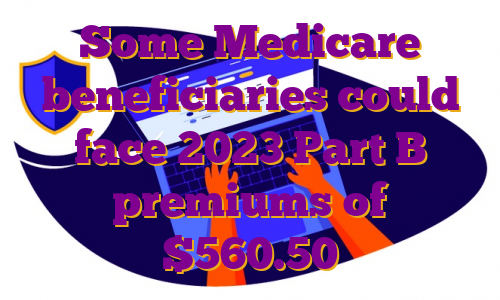Mike Mergen | Bloomberg | Getty ImagesIf you’re a Medicare beneficiary, now’s the time to evaluate your prescription drug coverage for 2023.In addition to checking during Medicare’s annual fall open enrollment whether there’s a more cost-effective plan for you, some legislative changes take effect next year that may reduce how much you pay out of pocket for your coverage.”It’s a quality of life issue,” said Elizabeth Gavino, founder of Lewin & Gavino and an independent broker and general agent for Medicare plans. “Saving money on medications means there’s more Social Security money left for other necessities in life.”More from Year-End PlanningHere’s a look at more coverage on what to do finance-wise as the end of the year approaches:Medicare’s enrollment period opened Oct. 15 and runs through Dec. 7. Beneficiaries can make changes to their coverage during this period.Prescription drugs are generally delivered through Medicare Part D. Of the estimated 64.5 million people enrolled in Medicare, about 50 million have such coverage, through either a standalone Part D plan or an Advantage Plan — both of which are offered by private insurance companies. Advantage Plans deliver Part A (hospital coverage) and Part B (outpatient care) and usually Part D.Here are some changes you may notice next year, as well as some tips for what to look for when evaluating your options for 2023.Insulin costs will be cappedSome changes to prescription drug coverage, enacted as part of the Inflation Reduction Act, take effect next year. This include a monthly $35 cap on cost-sharing for insulin under Part D, which will start on Jan. 1. (Some plans may already offer a $35 cap.)Part D deductibles — which vary from plan to plan but cannot be more than $505 in 2023, up from $480 this year — also won’t apply to the covered insulin product. For beneficiaries who take insulin through a traditional pump (which falls under Part B), the benefit starts July 1.”Some of my clients had to choose between buying food and buying insulin [or] rationing the insulin to make it last longer, thereby taking much less than the prescribed amount,” Gavino said. “This was dangerous, and now they can use the right amount they need to live.”100% coverage for recommended vaccinesAdditionally, there will no longer be any cost-sharing for recommended inoculations under Part D beginning Jan. 1, including for the shingles vaccine. “In the past, many people paid quite a bit for the shingles vaccine because of Part D’s rather high deductible,” said Danielle Roberts, co-founder of insurance firm Boomer Benefits.”The vaccine usually was a covered medication, but because they hadn’t yet satisfied the deductible, they spent quite a bit for it,” Roberts said. Other provisions that are intended to reduce Part D spending take effect in later years. This includes eliminating an existing 5% coinsurance in the so-called catastrophic phase of coverage (2024) and capping beneficiaries’ annual out-of-pocket Part D spending at $2,000 (2025). Currently, there is no out-of-pocket limit, regardless of whether you get your coverage as a standalone Part D option or through an Advantage Plan.Medicare also will be able to start negotiating the price of some drugs beginning in 2026.Your plan could change its list of covered drugsAs for choosing your 2023 coverage: While you aren’t required to take any action during open enrollment — your current coverage generally would continue into next year — plans often change their list of covered drugs and the price of them.Additionally, each plan assigns individual drugs to different tiers, with the first tier generally being the least expensive and the fifth costing the most. From year to year, various drugs may move from one tier to another in any given plan — which makes it important to check where your prescriptions fall for 2023.Also be sure to look at the pharmacies included in the plan. Some are “preferred” — meaning your medicine will be less expensive there than at a “standard” pharmacy.”The pharmacy you use can really impact the price of what you pay for your prescriptions,” said Ari Parker, a senior advisor at Chapter, a Medicare advisory firm.Beneficiaries with higher income pay more for coverageThe average premium for standard Part D coverage next year is projected to be $31.50, compared to $32.08 in 2022, according to the Center for Medicare & Medicaid Services. However, be aware that if your income is above certain limits, you will be subject to so-called income related adjustment amounts, or IRMAAs, which are in addition to any premium you pay (see chart below). Part B also comes with those extra amounts.Your tax return from 2021 is generally what would be used to determine whether you’re subject to those surcharges in 2023. You can ask for a reconsideration if your income has dropped since then.Getting prescription drug coverage through Medicare is optional. However, if you fail to sign up when you first qualify for coverage at age 65 and change your mind later, you’ll face a life-lasting penalty unless you meet certain exclusions (i.e., you receive acceptable coverage through an employer).The penalty is 1% of the national base premium for each month you didn’t have Part D or creditable coverage and should have.Be aware that while you can change your Advantage Plan early next year (Jan. 1 to March 31) if you discover it’s not a good fit, that’s not the case for standalone Part D plans.”Unless a special circumstance applies, you won’t be able to change it,” Parker said.Also, sometimes you can find medicines at a cheaper cost than through your plan, such as with a free drug-discount card. However, if you go this route instead of through your insurance, your plan won’t count the medicine’s cost and your copay toward your deductible or other calculations it uses to determine your share. .
Other provisions that are intended to reduce Part D spending take effect in later years. This includes eliminating an existing 5% coinsurance in the so-called catastrophic phase of coverage (2024) and capping beneficiaries’ annual out-of-pocket Part D spending at $2,000 (2025). Currently, there is no out-of-pocket limit, regardless of whether you get your coverage as a standalone Part D option or through an Advantage Plan.Medicare also will be able to start negotiating the price of some drugs beginning in 2026.Your plan could change its list of covered drugsAs for choosing your 2023 coverage: While you aren’t required to take any action during open enrollment — your current coverage generally would continue into next year — plans often change their list of covered drugs and the price of them.Additionally, each plan assigns individual drugs to different tiers, with the first tier generally being the least expensive and the fifth costing the most. From year to year, various drugs may move from one tier to another in any given plan — which makes it important to check where your prescriptions fall for 2023.Also be sure to look at the pharmacies included in the plan. Some are “preferred” — meaning your medicine will be less expensive there than at a “standard” pharmacy.”The pharmacy you use can really impact the price of what you pay for your prescriptions,” said Ari Parker, a senior advisor at Chapter, a Medicare advisory firm.Beneficiaries with higher income pay more for coverageThe average premium for standard Part D coverage next year is projected to be $31.50, compared to $32.08 in 2022, according to the Center for Medicare & Medicaid Services. However, be aware that if your income is above certain limits, you will be subject to so-called income related adjustment amounts, or IRMAAs, which are in addition to any premium you pay (see chart below). Part B also comes with those extra amounts.Your tax return from 2021 is generally what would be used to determine whether you’re subject to those surcharges in 2023. You can ask for a reconsideration if your income has dropped since then.Getting prescription drug coverage through Medicare is optional. However, if you fail to sign up when you first qualify for coverage at age 65 and change your mind later, you’ll face a life-lasting penalty unless you meet certain exclusions (i.e., you receive acceptable coverage through an employer).The penalty is 1% of the national base premium for each month you didn’t have Part D or creditable coverage and should have.Be aware that while you can change your Advantage Plan early next year (Jan. 1 to March 31) if you discover it’s not a good fit, that’s not the case for standalone Part D plans.”Unless a special circumstance applies, you won’t be able to change it,” Parker said.Also, sometimes you can find medicines at a cheaper cost than through your plan, such as with a free drug-discount card. However, if you go this route instead of through your insurance, your plan won’t count the medicine’s cost and your copay toward your deductible or other calculations it uses to determine your share. .
Some Medicare beneficiaries could face 2023 Part B premiums of $560.50
Shapecharge | E+ | Getty ImagesIf you’re a higher-income Medicare beneficiary, you may be paying less in extra premium charges in 2023 than you were this year.So-called income-related adjustment amounts, or IRMAAs, which are based on your tax return from two years earlier, kick in next year at $97,000 for single tax filers and $194,000 for joint filers (based on their 2020 return), up from $91,000 and $182,000, respectively.Additionally, with the standard Part B (outpatient care coverage) premium dropping by 3% next year to $164.90 from $170.10 in 2022, the IRMAAs also are less costly.The surcharges apply to both Part B and Part D (prescription drug coverage) premiums and affect about 7% of Medicare’s 64.3 million beneficiaries. The higher your income, the higher the charge. (See charts below.)Whether you have to pay the surcharge is based on your modified adjusted gross income as defined by the Medicare program: your adjusted gross income plus tax-exempt interest income.”You only have to go $1 over that [lowest] breakpoint and you’re subject to IRMAAs,” said certified financial planner Barbara O’Neill, owner and CEO of Money Talk, a financial education company. “If you’re close to that or close to going to a higher tier, you’ve really got to be proactive,” O’Neill said.In other words, there are some strategies and planning techniques that can help you avoid or minimize those IRMAAs. Here are four to consider:1. Focus on income streams under your controlWhile some income in retirement is generally set — i.e., Social Security and/or a pension — the key to avoiding IRMAAs is to focus on what income streams you can control, said CFP Judson Meinhart, senior financial advisor and manager of financial planning for Parsec Financial in Winston-Salem, North Carolina.”The key to keeping [your income] below the IRMAA brackets is planning ahead to know where your income is coming from,” Meinhart said.More from FA Playbook:Here’s a look at other stories impacting the financial advisor business.Be aware that the IRMAA determination is typically based on your tax return from two years earlier. If your income has dropped since then, you can appeal the IRMAA decision using Form SSA-44 and providing proof that you’ve experienced a “life-changing event” such as retirement, death of a spouse or divorce.2. Consider Roth IRA conversionsOne way to keep your taxable income down is to avoid having all of your nest egg in retirement accounts whose distributions are taxed as ordinary income, such as a traditional IRA or 401(k) plan. So whether you’ve signed up for Medicare yet or not, it may be worth converting taxable assets to a Roth IRA.Roth contributions are taxed upfront, but qualified withdrawals are tax-free. This means that while you would pay taxes now on the amount converted, the Roth account would provide tax-free income down the road — as long as you are at least age 59½ and the account has been open for more than five years, or you meet an exclusion.”You pay a little more now to avoid higher tax brackets or IRMAA brackets later on,” Meinhart said.It also helps that Roth IRAs do not have required minimum distributions, or RMDs, in the owner’s lifetime. RMDs are amounts that must be withdrawn from traditional IRAs, as well as both traditional and Roth 401(k) accounts, once you reach age 72.When RMDs from traditional accounts kick in, your taxable income could be pushed up enough that you become subject to IRMAAs, or to a higher amount if you already were paying the surcharge.”A lot of people get into trouble by taking no money out of their 401(k) plan or IRA, and then they have their first RMD and it puts them in one of those IRMAA brackets,” Meinhart said.3. Keep an eye on capital gainsIf you have assets that could generate a taxable profit when sold — i.e., investments in a brokerage account — it may be worth evaluating how well you can manage those capital gains. While you may be able to time the sale of, say, an appreciated stock to control when and how you would be taxed, some mutual funds have a way of surprising investors at the end of the year with capital gains and dividends, both of which feed into the IRMAA calculation. “With mutual funds, you don’t have a whole lot of control because they have to pass the gains on to you,” said O’Neill, of Money Talk. “The problem is you don’t know how big those distributions are going to be until very late in the tax year.” Depending on the specifics of your situation, it may be worth considering holding exchange-traded funds instead of mutual funds in your brokerage account due to their tax efficiency, experts say.For investments whose sale you can time, it’s also important to remember the benefits of tax-loss harvesting as a way to minimize your taxable income.That is, if you end up selling assets at a loss, you can use those losses to offset or reduce any gains you realized. Generally speaking, if the losses exceed the profit, you can use up to $3,000 per year against your regular income and carry forward the unused amount to future tax years.4. Tap your philanthropic sideIf you’re at least age 70½, a qualified charitable contribution, or QCD, is another way to keep your taxable income down. The contribution goes directly from your IRA to a qualified charity and is excluded from your income.”It’s one of the few ways you can really get money out of an IRA completely tax-free,” Meinhart said. “And when you’re 72, that charitable distribution can help offset your required minimum distributions.”The maximum you can transfer is $100,000 annually; if you’re married, each spouse can transfer $100,000. .
Depending on the specifics of your situation, it may be worth considering holding exchange-traded funds instead of mutual funds in your brokerage account due to their tax efficiency, experts say.For investments whose sale you can time, it’s also important to remember the benefits of tax-loss harvesting as a way to minimize your taxable income.That is, if you end up selling assets at a loss, you can use those losses to offset or reduce any gains you realized. Generally speaking, if the losses exceed the profit, you can use up to $3,000 per year against your regular income and carry forward the unused amount to future tax years.4. Tap your philanthropic sideIf you’re at least age 70½, a qualified charitable contribution, or QCD, is another way to keep your taxable income down. The contribution goes directly from your IRA to a qualified charity and is excluded from your income.”It’s one of the few ways you can really get money out of an IRA completely tax-free,” Meinhart said. “And when you’re 72, that charitable distribution can help offset your required minimum distributions.”The maximum you can transfer is $100,000 annually; if you’re married, each spouse can transfer $100,000. .
A possible reduction for Medicare Part B premiums is still in play
Choreograph | iStock | Getty ImagesFor Medicare beneficiaries wondering whether their Part B premiums could be reduced, the waiting continues.More than three months after Health and Human Services Secretary Xavier Becerra ordered a reassessment of this year’s $170.10 standard monthly premium — a bigger-than-expected jump from $148.50 in 2021 — it remains uncertain when a determination will come and whether it would affect what beneficiaries pay this year.”A mid-course reduction in premiums would be unprecedented,” said Tricia Neuman, executive director of the Medicare policy program at the Kaiser Family Foundation.More from Personal Finance:
Here’s how to buy new work clothes on a budget
These are the best and worst U.S. places to die
Be sure to manage this risk as you near retirementA spokesperson for the Centers for Medicare & Medicaid Services said the agency continues to reexamine the premium and will announce further information when it’s available.About half of the larger-than-expected 2022 premium increase, set last fall, was attributed to the potential cost of covering Aduhelm — a drug that battles Alzheimer’s disease — despite actuaries not yet knowing the particulars of how it would be covered because Medicare officials were still determining that.By law, CMS is required to set each year’s Part B premium at 25% of the estimated costs that will be incurred by that part of the program. So in its calculation for 2022, the agency had to account for the possibility of broadly covering Aduhelm.Certainly the rationale for an increase that high is gone.Paul GinsburgNonresident senior fellow at the Brookings InstitutionThings have changed, however.Several weeks ago, CMS officials announced that the program will only cover Aduhelm for beneficiaries who receive it as part of a clinical trial. Additionally, the per-patient price tag that actuaries had used in their calculation last year was cut in half, effective Jan. 1, by manufacturer Biogen — to $28,000 annually from $56,000.”Certainly the rationale for an increase that high is gone,” said Paul Ginsburg, a nonresident senior fellow at the Brookings Institution and a health care policy expert. “The question would be what’s administratively feasible.”If a premium reduction occurs, there’s also the chance it could be applied for 2023 instead of 2022. There have been year-to-year drops in the Part B premium in the past for various reasons, including legislative changes to how the premium is calculated.”If I were administering this, I’d be concerned about setting a precedent for making changes in the middle of the year,” Ginsburg said.It’s also possible that lower-than-projected spending on Aduhelm could be at least partially offset by increased costs in other areas of Part B coverage, which includes outpatient care and medical equipment. While Medicare Part D provides prescription drug coverage, some medicines are administered in a doctor’s office — as with Aduhelm, which is delivered intravenously — and therefore covered under Part B.”Even if fewer people are using Aduhelm than originally projected and at a lower price than assumed, the actuaries may be inclined to take into account other changes that could moderate that amount,” Neuman said.Roughly 6 million Americans suffer from Alzheimer’s, a degenerative neurological disease that slowly destroys memory and thinking skills, and has no known cure. It also can destroy the lives of families and friends of those with the disease.Most of these patients are age 65 or older and generally enrolled in Medicare, which covers more than 63 million individuals. In 2017, about 2 million beneficiaries used one or more of the then-available Alzheimer’s treatments covered under Part D, according to the Kaiser Family Foundation. .
Enrolling in Medicare? Here are three key things you need to know
andresr | E+ | Getty ImagesMedicare may seem like a maze when you first try to navigate it.After all, there are different “parts” to the federal health insurance program, which provides coverage for about 56.5 million individuals in the 65-and-older crowd. And, whether you’re reaching the eligibility age of 65 or you are older and switching from workplace insurance to Medicare, there are some important factors to consider that affect your wallet.First, however, it’s worth knowing the basics: Original Medicare consists of Part A (hospital coverage) and Part B (outpatient care).More from Investor Toolkit:
3 tips for paying down your credit card balances
Democrats call for action on Social Security reform
Investors are flocking to green energy fundsSome beneficiaries choose to get those benefits delivered through an Advantage Plan (Part C), which typically includes prescription drug coverage (Part D). Others stick with original or basic Medicare and, possibly, pair it with a standalone Part D plan and a so-called Medigap policy.Here are three key things to be aware of as you prepare to enroll.1. It’s going to cost youMedicare is not free.”This comes as a surprise to so many beneficiaries who have paid [payroll] taxes throughout their working lifetimes and assumed this would mean Medicare would be ‘paid up’ by the time they turn 65,” said Danielle Roberts, co-founder of insurance firm Boomer Benefits.”Those taxes will mean no premiums for Part A, but Parts B and D have premiums that beneficiaries pay monthly throughout their retirement years,” Roberts said.Premium-free Part A is available as long as you have at least a 10-year work history of paying into the system via payroll taxes. If not, monthly premiums could be as much as $499 in 2022, depending on whether you’ve paid any taxes into the Medicare system at all.Spouses without their own work history may qualify for premium-free Part A as well.Part A also has a deductible of $1,566, which applies to the first 60 days of inpatient hospital care in a benefit period. For the 61st through 90th days, beneficiaries pay $389 per day, and then $778 per day for 60 “lifetime reserve” days.Meanwhile, Part B’s standard monthly premium is $170.10 this year. However, some beneficiaries pay more through income-adjusted surcharges.”Many of my high-income earners are shocked at how much Medicare premiums will cost them in retirement,” said Elizabeth Gavino, founder of Lewin & Gavino and an independent broker and general agent for Medicare plans. The government uses your tax return from two years earlier to determine whether you’ll pay extra. To request a reduction in that income-related amount due to a life-changing event such as retirement, the Social Security Administration has a form you can fill out.Part B also has a deductible: $233 in 2022. Once that’s met, beneficiaries generally are responsible for 20% of covered services. Part D premiums, deductibles and copays depend on the specifics of the coverage. The average premium this year is about $32, according to the Centers for Medicare & Medicaid Services. And, as with Part B, higher earners are charged extra through IRMAAs.2. Missing key deadlines can mean paying extraIf you’re planning to sign up for Medicare as soon as you’re eligible at age 65, you get a seven-month “initial enrollment period” that starts three months before the month of your 65th birthday and ends three months after it.Meanwhile, if you delayed signing up at age 65 because you continued to work and your employer coverage was acceptable (according to Medicare standards), you get eight months to enroll once your workplace plan ends.Regardless of the enrollment rules your subject to, missing the deadline to sign up for Part B can result in a life-lasting late-enrollment penalty. For each full year that you should have been enrolled but were not, you’ll pay 10% of the monthly Part B standard premium.”Many of my high-income earners are shocked at how much Medicare premiums will cost them in retirement.Elizabeth GavinoFounder of Lewin & GavinoPart D also has a late-enrollment penalty if you miss the deadline. For people signing up during their initial enrollment period at age 65, you get the same seven months for Part D as you do for Part B. However, if you’re beyond that window and your workplace coverage is ending, you get two months to enroll in Part D, whether as a standalone plan or through an Advantage Plan.The penalty is 1% of the national base premium for each month you didn’t have Part D or creditable coverage and should have.3. Supplemental insurance may make senseThe various costs associated with basic Medicare may be different if you have supplemental coverage.One option is to enroll in an Advantage Plan. While you would generally continue to pay your Part B premiums, many plans have a low or zero premium. And in addition to usually including prescription drug coverage, Advantage Plans also may offer extras such as dental, vision and hearing. Advantage Plans come with a cap on out-of-pocket spending, unlike basic Medicare. Their cost-sharing structures — i.e., deductibles, copays or coinsurance — also are different and vary from plan to plan.However, the annual maximum out-of-pocket can be high: in 2021, it averaged $5,091, according to the Kaiser Family Foundation. You also may be required to use certain doctors, hospitals and pharmacies.”These plans have networks of providers and some plans will require you to choose a primary care physician and get referrals to see certain providers and prior authorizations for many of the more expensive procedures, tests and surgeries,” Roberts said.Your other option is Medigap, which picks up some cost-sharing associated with basic Medicare, such as the Part A deductible or Part B copays. These policies are offered by private insurance companies as well, but are generally standardized — same-named plans offer identical benefits no matter which insurer sells it. Available Medigap policies are designated A, B, C, D, F, G, K, L, M and N and each offers a different level of coverage.However, they can be pricey, depending on the insurer and where you live. A 65-year-old woman in Dallas might pay under $100 monthly for Plan G, while in New York that same person would pay $278, according to the American Association for Medicare Supplement Insurance. And, generally speaking, those premiums rise over time.Choosing between an Advantage Plan or Medigap (or neither) can involve things that go beyond cost and depend on the specifics of your situation. This makes it worth consulting with either an experienced Medicare agent or your local State Health Insurance Assistance Program, otherwise known as SHIP, and neither would cost you anything for guidance.”There are many factors to consider when choosing between these two options,” Gavino said. .
Strategies can help you avoid paying extra for Medicare premiums
Morsa Images | DigitalVision | Getty ImagesFor some retirees, there’s an extra cost associated with Medicare premiums that can ambush their household budgets.Most Medicare enrollees pay the standard premium amounts for Part B (outpatient care) and Part D (prescription drugs). Yet an estimated 7% of Medicare’s 64.3 million beneficiaries end up paying extra because their income is high enough for income-related monthly adjustment amounts, or IRMAAs, to kick in, according to the Centers for Medicare & Medicaid Services.Whether you have to pay the surcharge is based on your modified adjusted gross income as defined by the Medicare program: your adjusted gross income plus tax-exempt interest income. For 2022, IRMAAs kick in when that amount is more than $91,000 for individuals or $182,000 for married couples filing joint tax returns. The higher your income, the larger the surcharge is.”You only have to go $1 over that [lowest] breakpoint and you’re subject to IRMAAs,” said certified financial planner Barbara O’Neill, owner and CEO of Money Talk, a financial education company. “If you’re close to that or close to going to a higher tier, you’ve really got to be proactive,” O’Neill said.In other words, there are some strategies and planning techniques that can help you avoid or minimize those IRMAAs. Here are four to consider:1. Focus on what you can control2. Consider converting to Roth IRA accountsOne way to keep your taxable income down is to avoid having all of your nest egg in retirement accounts whose distributions are taxed as ordinary income, such as a traditional IRA or 401(k). So whether you’ve signed up for Medicare yet or not, it may be worth converting taxable assets to a Roth IRA.Roth contributions are taxed upfront, but qualified withdrawals are tax-free. This means that while you would pay taxes now on the amount converted, the Roth account would provide tax-free income down the road — as long as you are at least age 59½ and the account has been open for more than five years, or you meet an exclusion.”You pay a little more now to avoid higher tax brackets or IRMAA brackets later on,” Meinhart said.It also helps that Roth IRAs do not have required minimum distributions, or RMDs, in the owner’s lifetime. RMDs are amounts that must be withdrawn from traditional IRAs as well as both traditional and Roth 401(k)s once you reach age 72.When RMDs from traditional accounts kick in, your taxable income could be pushed up enough that you become subject to IRMAAs, or to a higher amount if you already were paying the surcharge.”A lot of people get into trouble by taking no money out of their 401(k) or IRA, and then they have their first RMD and it puts them in one of those IRMAA brackets,” Meinhart said.3. Keep an eye on capital gainsIf you have assets that could generate a taxable profit when sold — i.e., investments in a brokerage account — it may be worth evaluating how well you can manage those capital gains. While you may be able to time the sale of, say, an appreciated stock to control when and how you would be taxed, some mutual funds have a way of surprising investors at the end of the year with capital gains and dividends, both of which feed into the IRMAA calculation. “With mutual funds, you don’t have a whole lot of control because they have to pass the gains on to you,” said O’Neill, of Money Talk. “The problem is you don’t know how big those distributions are going to be until very late in the tax year.”Depending on the specifics of your situation, it may be worth considering holding exchange-traded funds instead of mutual funds in your brokerage account due to their tax efficiency, experts say.For investments whose sale you can time, it’s also important to remember the benefits of tax-loss harvesting as a way to minimize your taxable income.That is, if you end up selling assets at a loss, you can use those losses to offset or reduce any gains you realized. Generally speaking, if the losses exceed the profit, you can use up to $3,000 per year against your regular income and carry forward the unused amount to future tax years.4. Tap your philanthropic sideIf you’re at least age 70½, a qualified charitable contribution, or QCD, is another way to keep your taxable income down. The contribution goes directly from your IRA to a qualified charity and is excluded from your income.”It’s one of the few ways you can really get money out of an IRA completely tax free,” Meinhart said. “And when you’re 72, that charitable distribution can help offset your required minimum distributions.”The maximum you can transfer is $100,000 annually; if you’re married, each spouse can transfer $100,000. .










